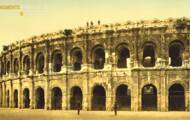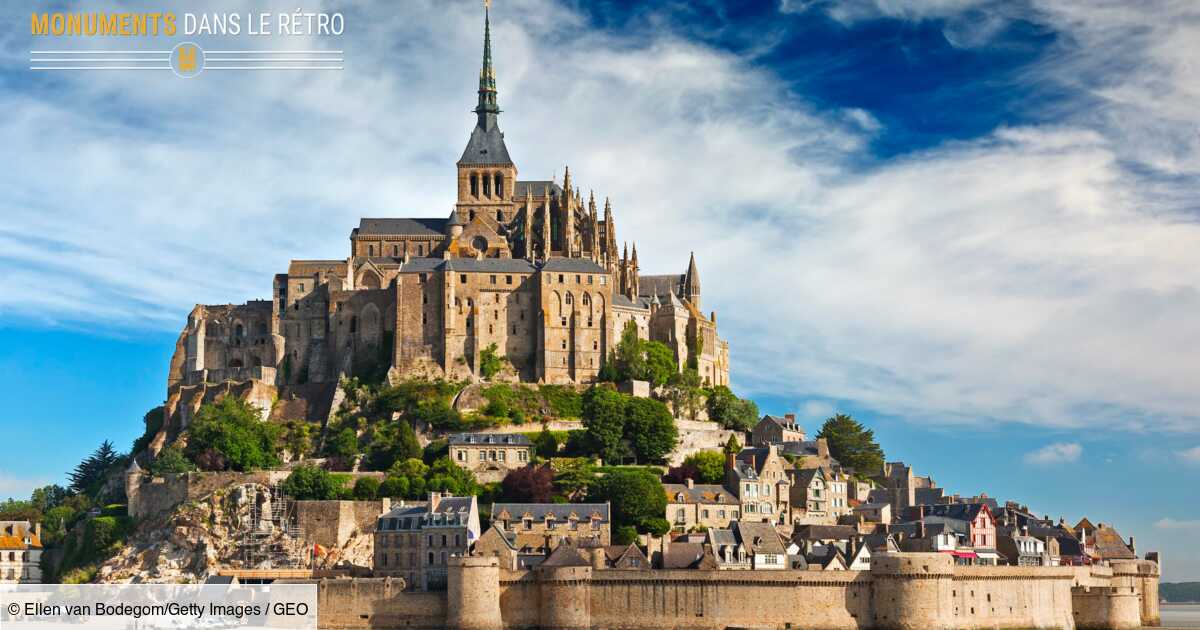Placed directly on the sea, Mont-Saint-Michel stands proudly in the middle of its bay, its summit pointing towards the sky. Its impressive mass, surrounded by sand at low tide, is connected to a footbridge that winds its way down to dry land. A unique architecture in the world that attracts more than two million tourists every year.
This attendance makes the rocky islet, listed as a UNESCO World Heritage Site since 1979, the most visited tourist site in Normandy and one of the most popular in France. Especially during periods of high tide which offers an exceptional spectacle when the water rushes into the bay, engulfing the sandy expanses at full speed.
⋙ What are the most beautiful cities in Normandy?
But Mont-Saint-Michel also attracts visitors thanks to its “Marvel”, a remarkable set of Gothic constructions raised on three levels which can be reached by climbing the only cobbled street of the mountain and entering its abbey. A heritage that has been built over the centuries and has long aroused curiosity.
In 1864, the construction was already making a certain impression, as evidenced by this report published in the Illustrated World February 20:
“Mont Saint-Michel, from the first sight, produces the impression of something extraordinary: for some, it is monstrous; for all, it is strange”. These few words, which we borrow from the descriptive itinerary of Mont Saint-Michel by M. Edouard le Héricher, admirably express the sensation one experiences the first time one looks at this rock which soars from the bosom of the waves. Indeed, nothing is missing at Mont Saint-Michel to produce bizarre sensations; it has the grandeur of the site and the poetry of the legends.
Twenty years later, on January 17, 1884, it was the turn of the newspaper The daily newspaper to marvel at the treasures of Mont-Saint-Michel:
There are few, on our wonderful land of France, monuments as complete in their historical importance as Mont Saint-Michel. Standing at the end of the Normandy coast, the old castle raises its formidable mass in the middle of the sea. Only at low tide, you can approach it on dry foot.
Ahead stretch the quicksands and dunes of Pontorson and Dol; and against the blue background of the sky, the thousand spiers, the pinnacles of the Gothic cathedral, the small columns stand out with superb clarity. The traveler who. Coming from land, sees this pile of superimposed houses, climbing one another like shipwrecked people surprised by the rising tide, receives an unforgettable impression.
An oratory on “Mont Tombe”
To grasp the historical importance of the place, you have to go back in time more than a millennium. Historical sources indicate that the first buildings on the islet date back to the 6th century. But it was at the beginning of the 8th century that an oratory was built there by Aubert, bishop of Avranches, to honor the Archangel Saint Michael.
Legend has it that the building was requested by the archangel himself, who appeared in a dream of the bishop. However, it would have taken three appearances – and a hole in his head – for Aubert to engage in the construction of the oratory. At that time, the islet did not yet bear its current name but was called “Mont Tombe”.
It was only after the nickname of Mont Saint-Michel (in full version “Mont-Saint-Michel-at-the-peril-of-the-Sea) is gradually adopted. Despite the location of the islet, the shifting sands and the threatening tides that surround it, pilgrims flock very quickly to this new spiritual place where a dozen canons officiate.
Then it is the population of the surroundings who come to take refuge there to escape the Viking raids. According to the arrivals, a village develops on the rock and the church gains in size. Until 966 when Richard I, then Duke of Normandy, decided to replace the canons with Benedictines. This is the date generally used for the foundation of the abbey of Mont-Saint-Michel.
Norman or Breton?
It is during this same period that the origins of the eternal bickering over the ownership of the islet can be found. Is he Norman or Breton? Normandy not existing during the construction of the first church and Brittany being made up of several kingdoms not extending until then, the question does not arise at the start.
The situation became more complicated in the middle of the 9th century when Brittany unified and annexed territories including that of Mont-Saint-Michel. Less than a hundred years later, in 933, Cotentin and Avranchin fell under the influence of the young Duchy of Normandy, which gradually asserted its domination there. It’s official, the mountain becomes a Norman island.
⋙ How, in 911, Normandy was born on the banks of the Epte
Over the following centuries, the abbey, which had become too small, underwent numerous transformations with the addition of new buildings, including a church and crypts. It was in the 13th century that the Marvel, which notably includes the refectory, the cloister and lodgings, completed the building thanks to a donation from the King of France Philippe Auguste.
The Hundred Years War spared neither the islet nor the abbey, both besieged for three decades by the English. The Romanesque choir of the abbey church collapsed but the mountain held firm until the liberation of Normandy in 1450.
A time changed in prison
At the end of the 18th century, the abbey experienced a new turning point. Its religious influence in decline and its walls falling into ruins, it was deserted by the Benedictines and changed into a prison. Hundreds of detainees were incarcerated there until the middle of the 19th century when it was decided to return the place to its original purpose.
It is the return of the pilgrims and restoration work is undertaken to restore the abbey, classified as a historic monument in 1862, to its splendour. Successful operations, according to the newspapers of the time, including the Illustrated World quoted above. Other work was carried out in the 1890s, particularly on the bell tower and the spire, victims of bad weather.
In 1879, an elevated road on a dyke was also built to facilitate access to the rock, and to promote the development of local tourism. The bet pays off in terms of tourism, but the project has sparked debate from its conception, with some denouncing the end of the islet’s isolation. Like Aristide Briand who publishes in On the way on December 7, 1916 an open letter demanding the destruction of the dyke:
The Mont-Saint-Michel, Minister, is a total registered in the Great Book of French beauties. He sums up the ideal assessment of the centuries in which the idea of homeland was forged. Nothing can be added to it. Nothing should be taken away. Everything that conditions him is his, eternally. Because the Mount cannot exist outside its natural setting, it is appropriate that around its rocks and its ramparts, the immensity of the waves spreads out and that it remains on the waters like a nave without moorings. .
The train that travels on the dyke road drops visitors off at the foot of the rampart. There is no longer any need to brave the risks of the islet and pilgrims are no longer the only ones to venture there. They are accompanied by “softly cautious tourists” as the title describes them. On page in an article published on October 9, 1930:
Here we are. The train stops in front of the rampart… Fortunately!… It is not in vain that industrial… progress approaches our artistic and picturesque marvels; he profane them. Mont-Saint-Michel is no longer an island; it is a peninsula connected to the land by a dike without beauty and without reason. The sluggish clunker that drops us off here “carries in the flowerbeds” of art and literature. Farewell, Saint-Michel at the peril of the sea! Farewell, poignant pages of the Enlisement! No more difference between the risk-averse pilgrims and the cautiously cautious tourist. Both disembark in front of the hotel porters, lined up along the seawall.
At the same rate as the influx of visitors, it is also the shops and accommodation that are multiplying. They are the distant heirs of the inns, taverns and stalls of religious objects that had set up shop in the Middle Ages. Among them is the “mère Poulard” inn, which quickly made a name for itself with its soufflé omelettes. A dish on which the reporterOn page obviously did not make the impasse:
We had two days. It’s not too much to get used to the “variations” of the sky, the sea and… the inhabitants. To digest the famous omelettes of mother Poulard (the name of Poulard is over there like a title of nobility that the hoteliers fight over…), aperitifs and filter coffees are offered to you at every step, in the street […] From the Porte du Roi to the parish church, your arrival is greeted with joyful cries.
We can also see in the photos accompanying the report a cobbled street teeming with people which is reminiscent of the scenes that can be observed today when the season is in full swing and hundreds of curious venture up Mt. But now no more dyke road that drops you off at the foot of the ramparts.
In addition to depriving the rock of its original nature, the construction had negative consequences on the local environment, increasing the amplitude of the tides, already the strongest in Europe, and causing the silting up of the bay. It was destroyed in 2015 as part of the project to restore the maritime character of Mt.
⋙ Mont-Saint-Michel becomes an island again
It is now a footbridge, open to pedestrians, bicycles, shuttles and horse-drawn carriages but not to cars, which connects the islet to the mainland. A narrow path that leaves plenty of time to contemplate the exceptional landscape that surrounds Mont-Saint-Michel and to explore – with a guide only – the mudflats of the bay.
>> Find in this section all the articles in partnership with RetroNews, the BNF press site. And if you are passionate about newspaper archives, RetroNews has launched its quarterly magazine which offers an exploration of historical events and periods through the press of the time. It is available in newsstands, in bookstores and online.
Read also :
How the Notre-Dame de la Garde basilica became one of the emblems of Marseille
– –

A look back at the history of Limoges Bénédictins station, one of the most beautiful in France
– –

The arenas of Nîmes or the revival of a 2000 year old Roman amphitheater
– –
–


